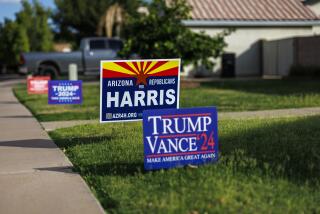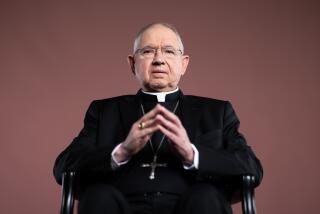Mormons Reach Out for Latino Converts : Religion: Spanish-speaking people are among the fastest-growing group in the Latter-day Saints, church officials say.
In the rural Mexican town where Renan Disner grew up, Catholicism was passed down generation to generation like Spanish.
Every Sunday, young Renan would accompany his grandmother to Mass at the church in Chiapas, mesmerized by a likeness of Jesus Christ displayed in a glass case.
Eventually, he began to sense that something was missing. What troubled him most was that he could not understand a word because the Mass was in Latin.
When he was 11, a friend invited him to a Mormon youth activity that would change his life. “I was baptized (as a Mormon) at 14, and since that day, everything in my life has been good,” said Disner, now a 32-year-old life insurance salesman in Santa Ana. “I have never tasted alcohol, beer or cigarettes, and I have never been with anyone but my wife.”
Disner, who heads the all-Latino Santa Ana stake (the administrative equivalent of a diocese in the Roman Catholic Church) in Orange County, is a testament to the Church of Jesus Christ of Latter-day Saints’ remarkable success in recruiting Latinos. Today, Latinos are the fastest-growing ethnic group in the conservative denomination that once barred blacks from its priesthood and until a decade ago had few nonwhites in its ranks.
It is a phenomenon occurring not only in California but throughout the Southwest--anywhere, Mormon officials say, where there are large concentrations of Latinos.
The church’s efforts have been particularly fruitful in Southern California. At last count, there were 24,000 Latino Mormons living in the region, nearly three times as many as in 1981, Mormon officials say.
In Van Nuys, two Latino wards (congregations), each with more than 800 members, had grown so quickly that church officials were recently forced to split each ward in two.
This same kind of rapid growth is also evident in Ventura County where church officials estimate that as much as one-fourth of the missionary force is deployed in predominantly Latino neighborhoods.
In Orange County, almost half of the 1,224 new Mormon converts in 1991 were Latino. Last month, the California Anaheim Mission formed the second stake in the country made up entirely of congregations with Spanish-speaking members. The other stake is in East Los Angeles.
However, the Church of Jesus Christ of Latter-day Saints’ aggressive efforts to attract Latinos has been limited to Southern California.
In the Bay Area, church officials estimate that as many as 20% of all new baptisms are Latino. The church has established a presence in Oakland, Sacramento, Bakersfield, Modesto, Chico, Stockton and Fresno.
“In rural areas like Fresno, you have a lot of missionaries who are assigned to work the farms,” said Keith Atkinson, a spokesman for the Mormons’ regional office in Los Angeles. “However, the church’s focus has been to start in the cities and work out to the rural areas.”
These communities are being tapped by missionaries eager to spread the teachings of “Jose Smith,” for Joseph Smith, founder of the church, as the result of an official church policy to attract Latinos.
For Disner, Mormon beliefs are patterned after the true teachings of Jesus Christ. “I have finally found a church that fills me up,” he said.
The Church of Jesus Christ of Latter-day Saints has its origins in the early 1800s. According to Mormon teachings, Smith, a 14-year-old farm boy, was first visited in Palmyra, N.Y., by two visions who identified themselves as God the Father and his Son, Jesus Christ. Smith had gone to the woods to pray for guidance because he was confused over the multitude of religious faiths that all claimed to be the only true faith.
For years, the church was almost exclusively white, but more recently its doctrine and practices have found a broader following.
Mormon teachings stress family values and self-sufficiency. Once a month, home teachers (official church representatives) visit families to provide spiritual guidance and report on their welfare to church officials.
Members are also required to live by a strict health code. They do not smoke, or drink alcohol or caffeinated beverages.
Church officials said the Mormon emphasis on strengthening family units appeals to Latinos. The church encourages families to hold weekly meetings to study principles of sound living and to discuss family matters.
Church officials also attribute the rapid growth in the Spanish-speaking church population to flourishing domestic and foreign missions throughout Mexico and Latin America.
There are about 2 million Latino Mormons in Latin America--1 million in Mexico alone, church officials say.
Consequently, church officials said, the Mormon faith no longer is the white-centered religion it was 20 years ago. Officials now estimate that 50% of the congregants worldwide are Spanish-speakers.
As a result, many young missionaries carry copies of “El Libro de Mormon,” and “Santa Biblia,” Spanish versions of the Book of Mormon and the Bible. In preparation for their two-year missions--a requirement for devout Mormons--many take intensive Spanish-language training at church headquarters in Salt Lake City.
The large numbers of Latino conversions and proselytizing of Spanish-speaking peoples have struck a raw nerve among some in the leadership of the Roman Catholic Church, which for centuries has been the predominant religion among Latinos.
Last year, a group of Catholic bishops in California accused Mormons of using coercive methods to lure Latinos from their heritage. The bishops also leveled allegations of “proselytizing at any cost” at Seventh-day Adventists, Jehovah’s Witnesses and other Pentecostal denominations, which have recently seen much growth among Latinos.
Mormon officials, however, deny that they have done anything improper to attract Latinos.
“We are not going to use coercive practices of any kind,” said Atkinson, the regional Mormon spokesman. “But we feel we have a mandate from God to preach his message, and we cannot say to Catholics that we are not going to offer it to people of yours who are interested.”
Church Elder Jeff Doyle, fresh out of the intensive language program in Salt Lake City and who never met a Latino back home in Pocatello, Ida., is “serving his mission” in the heavily Latino neighborhoods on Costa Mesa’s west end.
On a recent morning, he and a fellow missionary--Ruvinsky Espinoza, 19, from Puerto Rico--took to the streets on their fat-tired bicycles. They were immaculately dressed in starched white shirts, dress trousers, ties and brown, wingtip shoes. Backpacks bulged with Mormon literature. Both were seemingly oblivious to the 80-degree heat as they pedaled busy Fairview Street in tandem.
Their destination was the home of Alfonso Villegas, the first in a series of appointments with new believers, as well as potential converts. It was Doyle’s 22nd birthday; he will spend it spreading the Mormon faith until about 9:30 p.m.
These highly trained, young, male missionaries, part of a 200-member force in the county, are key elements of the church’s recruitment strategy. Their lives revolve around strict discipline and service to the church.
“It was a little difficult at first, because it’s not your normal youth lifestyle,” Doyle said. “But we have a different kind of fun. Preaching the Gospel is the most important thing in my life.”
Doyle and Espinoza exuded enthusiasm when they arrived at Villegas’ apartment.
The 42-year-old dishwasher greeted them effusively in Spanish.
Upstairs, the three men knelt in the center of a sparsely furnished bedroom and bowed their heads in prayer. A color picture of Jesus hung imposingly above them on a nearby wall.
Villegas, who is from Mexico, was baptized a Mormon in October. Since then, church members have visited him three times a week.
Villegas used to attend a Presbyterian church in Mexico--but only, he said, “because my wife wanted me to, not because of any religious faith that I felt.”
“But I’m very happy with the Mormons,” he said in Spanish. “I don’t know too much about them because it’s new, but they come here and help me very much.”
Once out the door, Doyle and Espinoza hopped on their bikes and headed for the next stop.
“We don’t try to convince people,” said Doyle, hoisting the backpack onto his shoulder. “We just invite them to read the Book of Mormon and pray, because we sincerely believe that God answers prayers and (that) they will see that what we are saying is true.”
Times staff writer John Dart contributed to this report.
More to Read
Sign up for Essential California
The most important California stories and recommendations in your inbox every morning.
You may occasionally receive promotional content from the Los Angeles Times.










